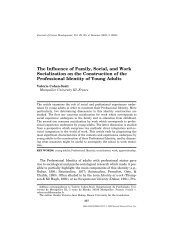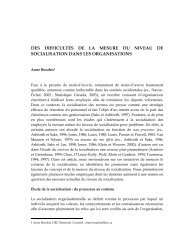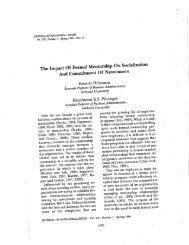Training in the 21st Century: Some Lessons from the Last One - Free
Training in the 21st Century: Some Lessons from the Last One - Free
Training in the 21st Century: Some Lessons from the Last One - Free
You also want an ePaper? Increase the reach of your titles
YUMPU automatically turns print PDFs into web optimized ePapers that Google loves.
36 Haccoun and Saks<br />
more attention must be given to <strong>the</strong> measurement of<br />
reaction measures (e.g., affective versus utility measures).<br />
Fur<strong>the</strong>r, reaction measures may play a complex <strong>in</strong>direct<br />
role on <strong>the</strong> o<strong>the</strong>r levels of tra<strong>in</strong><strong>in</strong>g criteria (i.e., learn<strong>in</strong>g<br />
and behaviour) and <strong>the</strong>refore deserve closer scrut<strong>in</strong>y <strong>in</strong><br />
future research.<br />
Fortunately, I-O psychologists have made a habit of<br />
"piggy-back<strong>in</strong>g" o<strong>the</strong>r measures, of greater relevance for<br />
assess<strong>in</strong>g tra<strong>in</strong><strong>in</strong>g success, on to affective reaction<br />
questionnaires and have been <strong>in</strong> <strong>the</strong> forefront of <strong>the</strong><br />
development of more sophisticated models of tra<strong>in</strong><strong>in</strong>g<br />
evaluation. <strong>One</strong> of <strong>the</strong> more important contributions has<br />
been proposed by Kraiger, Ford, and Salas (1993) who<br />
published a remarkable monograph which provides a<br />
considerable expansion and a <strong>the</strong>oretically based model<br />
of tra<strong>in</strong><strong>in</strong>g evaluation. As a result, we now have a classification<br />
scheme and a much better understand<strong>in</strong>g of <strong>the</strong><br />
cognitive, skill-based, and affective variables that should<br />
be measured <strong>in</strong> order to evaluate tra<strong>in</strong><strong>in</strong>g programs.<br />
Although <strong>the</strong>y consider this to be a classification scheme<br />
of learn<strong>in</strong>g outcomes, some of <strong>the</strong> outcomes <strong>in</strong> <strong>the</strong>ir<br />
affective category (i.e. self-efficacy and motivational<br />
disposition) can be subsumed as part of <strong>the</strong> measurement<br />
of reactions.<br />
Self-efficacy rema<strong>in</strong>s one of <strong>the</strong> more stable predictors<br />
of behaviour and performance <strong>in</strong> both tra<strong>in</strong><strong>in</strong>g (Saks,<br />
1997) as well as o<strong>the</strong>r areas of organizational accomplishment<br />
(Gist & Mitchell, 1992). S<strong>in</strong>ce <strong>the</strong> construction of<br />
selfefficacy measures is relatively straightforward and<br />
easily learned, tra<strong>in</strong>ers may f<strong>in</strong>d it very easy to <strong>in</strong>corporate<br />
such measures <strong>in</strong>to post-tra<strong>in</strong><strong>in</strong>g self-report type<br />
evaluations. Low self-efficacy leveb might <strong>in</strong>dicate that<br />
<strong>the</strong> tra<strong>in</strong><strong>in</strong>g experience itself requires modification.<br />
Fortunately, Bandura (1997) has described a basic set of<br />
activities which, when <strong>in</strong>corporated <strong>in</strong>to a tra<strong>in</strong><strong>in</strong>g<br />
program, may well enhance tra<strong>in</strong>ee self-efficacy. In turn,<br />
this provides some easily followed guides that can help<br />
tra<strong>in</strong>ers develop and adm<strong>in</strong>ister better tra<strong>in</strong><strong>in</strong>g programs<br />
(more about this later).<br />
Similarly, measures of motivation to learn and motivation<br />
to transfer might also be profitably <strong>in</strong>tegrated <strong>in</strong>to<br />
"reaction" type measures. Mathieu et al. (1992) among<br />
o<strong>the</strong>rs (for example, Haccoun, 1997) suggest <strong>the</strong> use of<br />
<strong>the</strong> VIE model, a standard <strong>in</strong> <strong>the</strong> discipl<strong>in</strong>e, as a practical<br />
operationalization of <strong>the</strong> motivation dimension. The VIE<br />
approach requires separate questions to measure valence,<br />
<strong>in</strong>strumentality, and expectancies related to<br />
learn<strong>in</strong>g and/or us<strong>in</strong>g <strong>the</strong> tra<strong>in</strong><strong>in</strong>g material. Separate<br />
analyses of <strong>the</strong>se sub-<strong>in</strong>dices provide more specific<br />
<strong>in</strong>sights <strong>in</strong>to <strong>the</strong> parameters which weaken tra<strong>in</strong><strong>in</strong>g<br />
effects. For example, know<strong>in</strong>g that valences are low may<br />
<strong>in</strong>dicate that <strong>the</strong> tra<strong>in</strong><strong>in</strong>g is perceived to be of low<br />
priority to tra<strong>in</strong>ees while low expectancy rat<strong>in</strong>gs might<br />
<strong>in</strong>dicate that <strong>the</strong> tra<strong>in</strong><strong>in</strong>g is not perceived as applicable<br />
to <strong>the</strong> tra<strong>in</strong>ees given <strong>the</strong>ir organizational context. The<br />
tra<strong>in</strong><strong>in</strong>g situation and/or <strong>the</strong> organizational environment<br />
might <strong>the</strong>n be appropriately amended to correct<br />
<strong>the</strong> specific threat to motivation.<br />
In sum, reaction measures should be designed to<br />
extract more <strong>in</strong>formation. For example, <strong>the</strong>y should<br />
<strong>in</strong>clude self-efficacy measures (s<strong>in</strong>ce <strong>the</strong>y are a strong<br />
predictor of transfer) as well as motivation to learn and<br />
motivation to transfer. Reaction measures should <strong>in</strong>clude<br />
utilityjudgements or usefulness rat<strong>in</strong>gs <strong>in</strong> addition to <strong>the</strong><br />
more traditional affective reactions (Alliger et al., 1997;<br />
Warr & Bunce, 1995). The use of reaction measures is<br />
prevalent and totally accepted by organizational tra<strong>in</strong>ers.<br />
It rema<strong>in</strong>s for us to work with our applied counterparts<br />
to better understand <strong>the</strong> role of reactions <strong>in</strong> tra<strong>in</strong><strong>in</strong>g<br />
effectiveness, and to <strong>in</strong>corporate o<strong>the</strong>r easily measured<br />
parameters <strong>in</strong>to <strong>the</strong> evaluation process <strong>in</strong> order to yield<br />
<strong>in</strong>formation that provides more mean<strong>in</strong>gful <strong>in</strong>sight <strong>in</strong>to<br />
<strong>the</strong> effectiveness of tra<strong>in</strong><strong>in</strong>g programs.<br />
Tra<strong>in</strong>ee Learn<strong>in</strong>g<br />
It is now reasonably habitual for organizations to assess<br />
<strong>the</strong> actual level of learn<strong>in</strong>g achieved dur<strong>in</strong>g tra<strong>in</strong><strong>in</strong>g.<br />
This is typically done by develop<strong>in</strong>g and adm<strong>in</strong>ister<strong>in</strong>g<br />
multiple choice or True-False formatted knowledge tests.<br />
However, <strong>the</strong>se measures tend to assess <strong>the</strong> level of<br />
declarative knowledge reta<strong>in</strong>ed by tra<strong>in</strong>ees. The difficulty,<br />
of course, is that declarative knowledge is an<br />
<strong>in</strong>sufficient predictor of behaviour use. More critical may<br />
be <strong>the</strong> extent of procedural knowledge acquired dur<strong>in</strong>g<br />
tra<strong>in</strong><strong>in</strong>g (see Kraiger et al., 1993).<br />
Declarative knowledge refers to <strong>the</strong> acquisition of<br />
facts while procedural acquisition refers to <strong>the</strong> <strong>in</strong>tegration<br />
of facts <strong>in</strong>to a set of orchestrated behaviour cha<strong>in</strong>s<br />
required for concrete action. This suggests <strong>the</strong> need for<br />
tra<strong>in</strong>ers to steer away <strong>from</strong> simple declarative knowledge<br />
tests, and to substitute <strong>the</strong>m for procedural assessments.<br />
The difficulty is that <strong>the</strong>re does not exist, to date, an<br />
acceptable or easily practical method for establish<strong>in</strong>g<br />
such knowledge <strong>in</strong> organizations. Current approaches<br />
such as verbal protocol analyses- or cognitive mapp<strong>in</strong>g<br />
methods like Pathf<strong>in</strong>der are extremely complex and time<br />
consum<strong>in</strong>g both to develop and to adm<strong>in</strong>ister, and as<br />
such <strong>the</strong>y are not f<strong>in</strong>d<strong>in</strong>g ready applicability <strong>in</strong> applied<br />
milieus.<br />
<strong>One</strong> promis<strong>in</strong>g approach has been offered by Ostroff<br />
(1991). Various scenarios rem<strong>in</strong>iscent of <strong>the</strong> situational<br />
<strong>in</strong>terview approach <strong>in</strong> selection (Latham, Saari, Pursell,<br />
&: Campion, 1980) are developed and tra<strong>in</strong>ees <strong>in</strong>dicate<br />
<strong>the</strong>ir likely course of action <strong>from</strong> a prepared list of<br />
alternatives. The answers provided are chosen to reflect<br />
various depths of understand<strong>in</strong>g of <strong>the</strong> key tra<strong>in</strong><strong>in</strong>g<br />
po<strong>in</strong>ts. While more complex than <strong>the</strong> development of<br />
simple multiple choice questions, this approach holds





